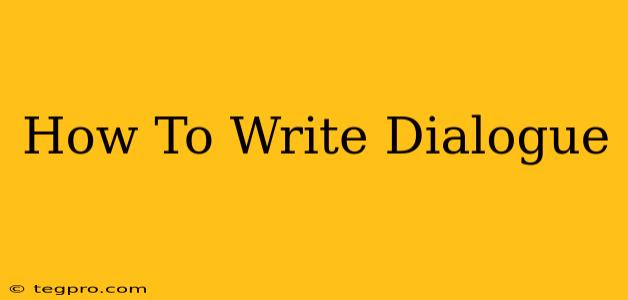Writing compelling dialogue is crucial for bringing your characters to life and captivating your readers. It's more than just characters talking; it's about revealing personality, advancing the plot, and creating a believable and engaging narrative. This guide will equip you with the tools to craft dialogue that truly shines.
Understanding the Purpose of Dialogue
Before diving into the mechanics, understand why dialogue is important. It doesn't exist solely to tell the reader what's happening; it serves several key functions:
- Character Development: Dialogue reveals personality traits, beliefs, and motivations. The way a character speaks—their vocabulary, tone, and sentence structure—tells the reader volumes about who they are.
- Plot Progression: Dialogue drives the story forward. It can reveal crucial information, create conflict, and advance the narrative arc.
- Building Tension: A tense exchange between characters can heighten the suspense and keep readers hooked.
- Creating Atmosphere: Dialogue helps establish the setting and mood of a scene. The language used can reflect the environment and the characters' emotional state.
- Showing, Not Telling: Strong dialogue shows the reader what's happening, rather than simply telling them. This is a fundamental principle of effective storytelling.
Crafting Realistic and Engaging Dialogue
Here are some key strategies for writing dialogue that feels authentic and draws the reader in:
1. Avoid On-the-Nose Dialogue
On-the-nose dialogue is where characters explicitly state what they're thinking or feeling. It's often clunky and unnatural. Instead of writing: "I'm so angry!" try showing the anger through actions and indirect dialogue. For example: "His knuckles whitened as he slammed his fist on the table. 'I've had enough!'"
2. Vary Sentence Structure and Tone
Monotonous dialogue quickly bores the reader. Mix short, sharp sentences with longer, more complex ones to mimic real-life conversation. Vary the tone to reflect the characters' emotions and the situation. A heated argument will sound different from a quiet conversation between friends.
3. Use Subtext
Subtext refers to the unspoken meaning behind the words. What is the character really saying? What are their underlying motives? Leaving things unsaid can create intrigue and depth.
4. Show, Don't Tell with Dialogue Tags
Dialogue tags (e.g., "he said," "she whispered") are necessary, but overuse can be disruptive. Instead of repeating "said," explore other options (e.g., muttered, exclaimed, sighed, chuckled). However, avoid overly flowery or distracting tags. Context should often make the tag unnecessary altogether.
5. Use Dialogue to Reveal Character Relationships
The way characters interact reveals the nature of their relationships. Are they close friends, bitter rivals, or something in between? Dialogue should reflect the dynamics between characters.
6. Read Your Dialogue Aloud
This is crucial! Reading your dialogue aloud helps you identify awkward phrasing, unnatural pacing, and repetitive dialogue tags. It will also help you hear the rhythm and flow of the conversation.
Beyond the Basics: Advanced Dialogue Techniques
- Dialect and Accent: Carefully consider using dialect or accent to create a stronger sense of place and character. But use it sparingly and authentically; overuse can be distracting.
- Silence: Sometimes, silence speaks louder than words. Use pauses and silences strategically to build tension or emphasize a character's emotional state.
- Interruptions: Interrupting each other is a natural part of conversation. Use interruptions to showcase personality clashes or urgent situations.
By focusing on these techniques, you can elevate your dialogue from simple conversation to a powerful storytelling tool that enhances your narrative and captivates your readers. Remember, practice makes perfect! The more you write, the better you'll become at crafting dialogue that truly shines.

